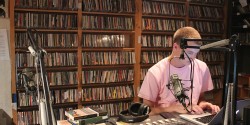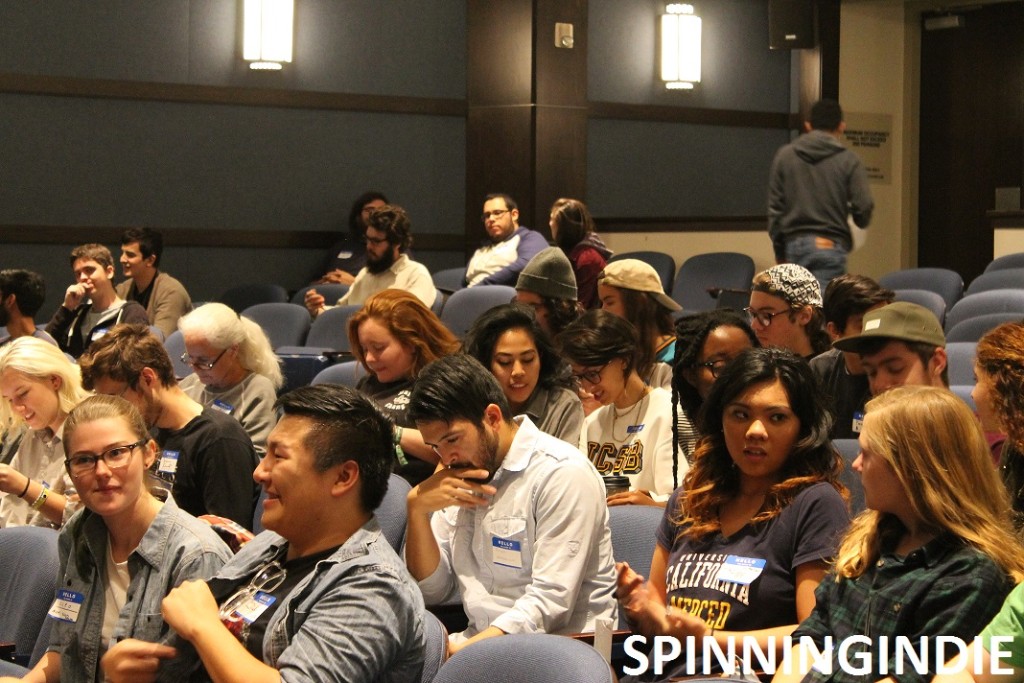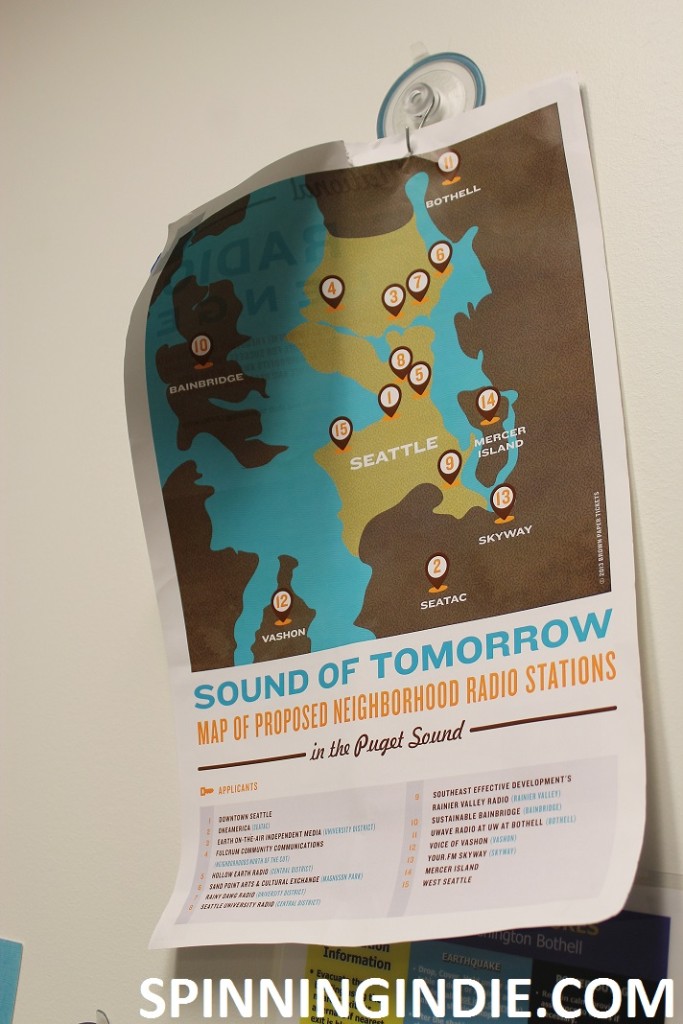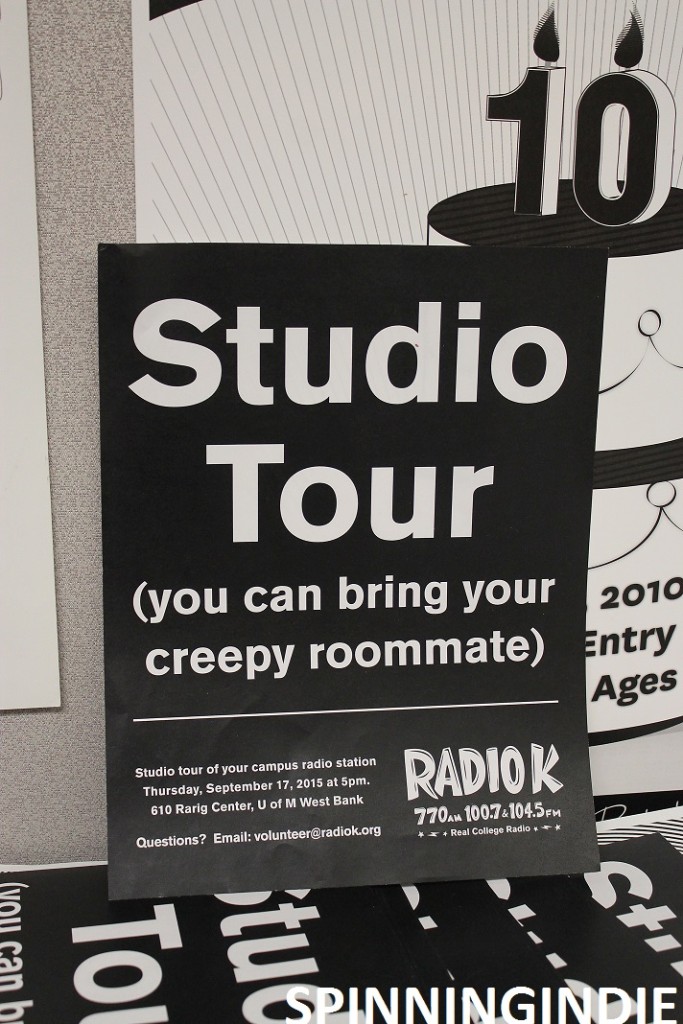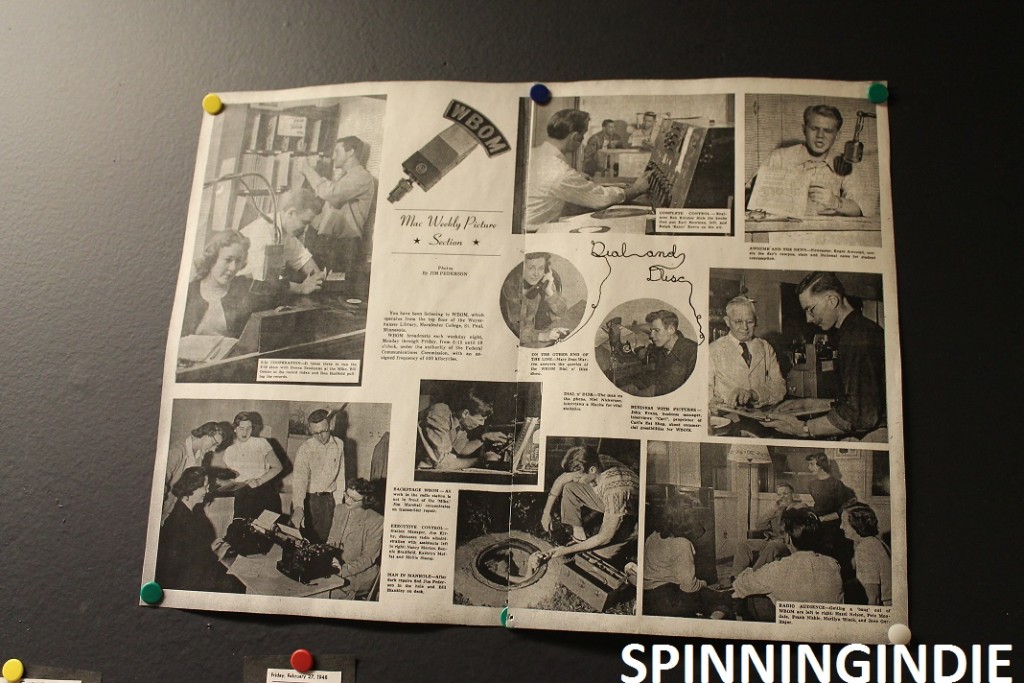Earlier this year when I was recapping the College Broadcasters Inc. (CBI) conference for the Radio Survivor Podcast (an event that I also spoke at), Paul asked me if there was an overarching sentiment or theme that I gleaned from the conference. I struggled to point out any specific theme and as I’ve spent more time mulling it over, I think it’s because 2015 was quite a varied year for college radio. Conference attendees weren’t buzzing about one major thing, instead, it was sort of business as usual.
Recapping 2015: New Stations, Awards & Projects + College Radio Watch’s Debut on Radio Survivor Podcast
A flurry of new stations got on the air (some were beneficiaries of new low power FM licenses), others changed frequencies, some had to move, and others faced budget challenges. Stations also came together and connected in person at conferences (including UCRN in California and the aforementioned CBI conference in Minneapolis) and virtually on College Radio Day. Speaking of College Radio Day, a crew of College Radio Day organizers and stations descended on the White House this September for an amazing visit, which included a tour and interviews with various officials. Later in the year, College Radio Day pulled together radio stations from all over the world in order to record messages of support for France following the November attacks on Paris.
As is the case every year, college radio stations received numerous awards and accolades. Besides the awards granted by broadcasting organizations, there is also a regular flow of lists that pop up on blogs and social media, including the often cited Princeton Review list. This summer I ranted a bit about these lists, as it’s always worth scrutinizing the methodology behind them.
Additionally, college radio stations took on a variety of interesting projects in 2015, including a bike race/scavenger hunt, video series, live concerts, collaborative mix tapes, a day party at the Hopscotch Music Festival presented by three North Carolina college radio stations, and even a live remote broadcast (with video) from Holland.
A few organizations also reached out to college radio this year with new products or series, including Cymbal, which has added a college radio category to its music discovery app. Public radio station KEXP introduced a new syndicated radio series, “Under the Needle,” which is being made available to college radio stations, and finally, CMJ added a regional college radio event, College Day on Tour, which debuted in Portland, Oregon in November. The group expects to host two regional college radio events each year. CMJ also announced that it was launching a radio show about college radio.
College radio organization, CBI also reached an agreement with SoundExchange over royalties paid by streaming college radio stations, with that settlement approved by The Copyright Royalty Board.
In 2015 we also got some updates on college radio stories that we’ve been following for years. In an interesting twist, the former KTRU frequency may now be up for sale. This doesn’t sit well with the many folks who protested the sale of the Rice University student radio station to University of Houston, so an alumnus DJ proposed that Rice University buy back the license. Also, the long fight over the sale of college radio station KUSF continued this year, as we learned that the FCC denied applications for review related to the license transfer.
I covered all this news throughout 2015 on Radio Survivor, mainly in my weekly College Radio Watch column. Starting in June, I also began reporting on college radio on the Radio Survivor Podcast, which has been an incredible outlet for expanding upon some of the topics covered on the website. Here are some specific highlights of the year in college radio:
LPFM a Boon for College Radio
12 Permits Granted to College Radio in 2015
The big college radio story for 2014 was that around 64 construction permits were issued to colleges and universities for new low power FM (LPFM) radio stations. By 2015, many of those stations made it to the air. Additionally, 12 more construction permits were handed out to college radio stations in 2015, including to: South Carolina State University (Orangeburg, SC), Brown Student Radio (Providence, RI), Holy Cross College, Inc. (South Bend, IN), Atlantic Cape Community College (Mays Landing, NJ), East Texas Baptist University (Marshall, TX), University of Oklahoma (Norman, OK), William Marsh Rice University (Houston, TX), UCentral Student Radio at University of Central Oklahoma (Edmond, OK), University of Texas at Dallas Amateur Radio Club in collaboration with Radio UTD (Richardson, TX), Barry University (Miami Shores, FL), The Reed Institute (Portland, OR), and Drury University (Springfield, MO).
Numerous LPFM Stations Launch in 2015
By December, 2015, numerous college radio LPFMs launched, including KVEX-LP (aka 97.5 Radio X FM) at St. Cloud State University in St. Cloud, Minnesota, Rice University station KTRU (whose official FCC call letters are the whimsical KBLT-LP), Forsyth Technical Community College station WFOZ-LP (Winston-Salem, North Carolina), Southeastern University’s WSEU-LP (Lakeland, Florida), East Mississippi Community College’s WGTC, Sweet Briar College’s station, The Briar, San Joaquin Delta College station KWDC (Stockton, CA), WVCU-LP at Concord University (Athens, West Virginia), and Hillsdale College’s WRFH in Hillsdale, MI (which is playing a mix of music and plans to air student shows in 2016).
Additionally, some college radio supporters are preparing to launch new LPFM stations, including the group (WRVU Friends and Family) that fought the sale of Vanderbilt’s College Radio Station WRVU. Now with a construction permit in hand, WXNA-LP is raising money in order to get on the air in Nashville, Tennessee.
Many College Radio Stations Launch Online or Over FM in 2015
This year, numerous college radio stations launched or were able to expand their presence.
A Bevy of New Streaming Radio Stations
Wofford College in Spartanburg, South Carolina launched streaming radio station WOCO Radio, reviving a long-time radio tradition on campus. Merrimack College also planned to launch an Internet radio, WMCK, station by fall and that goal was indeed realized. Other streaming radio stations were launched at California State University, Los Angeles, where Golden Eagle Radio debuted as a streaming radio station in April; at Moorpark College (Moorpark, CA) with KMCJ; and Upper Iowa University launched its streaming radio station KPCK this year as well. Over in the United Kingdom, Glasgow Clyde College launched a student radio station: Glasgow Clyde Radio, while in Canada, University of British Columbia Okanagan’s streaming radio station Heatwave Radio debuted.
New Terrestrial Stations, Power Increases for College Radio
Over FM, Columbus State University launched WCUG-FM, Cougar Radio, this summer in Columbus, Georgia and Coahoma Community College launched its new station. KRUX-FM got a new antenna for its 3000 watt broadcasts at New Mexico State University. Fort Valley State University gave up an existing LPFM radio station in order to launch a full power FM station. Eastern Oklahoma state also launched a full power station, KWLB 93.1 FM to augment the formerly online-only Mountaineer Radio. Sussex County Community College’s AM radio station was expected to branch out with its new WAMJ 97.5 FM channel by the fall. In Canada, Cape Breton University’s online station Caper Radio was granted approval to operate a low power FM radio station in Sydney, Nova Scotia.
LPFM Opportunity Allows Some Stations to Increase Power
In a few cases, college radio stations gave up existing licenses in order to get better coverage with new LPFM licenses. This was the case for St. Michael’s College in Colchester, Vermont and was also true for Southwestern College in Winfield, Kansas. By giving up its class D license, it was able to increase power over its new LPFM channel, KSWC-LP.
Collaborations and License Donations Bring College Radio to FM and HD Radio
I was happy to hear about some college radio stations collaborating with existing radio stations in order to get more airtime. University of Nevada, Reno’s online and 1700AM student radio station, Wolf Pack Radio, was able to move some of its programming to FM through a deal with community radio station KXNV. College of Lake County’s radio station Lancer Radio has been online-only, but began broadcasting over FM thanks to a partnership with LPFM community radio station WRLR-LP.
And in a very interesting case, students at Texas A&M were able to launch a commercial HD station, Fusion FM, thanks to a deal with Bryan Broadcasting. Additionally, community radio station KSVG Savage Radio was actively seeking college radio DJs for its station in Bakersfield, CA. In other good news, the non-profit group that owns KJZC is donating the non-commercial FM license to Chadron State College in Chadron, Nebraska for use as a student station. Hobart and William Smith College also became the official license holder for the student-run WHWS-LP, which was formerly licensed to an outside arts group (even though it was a student radio station).
Bad News: College Radio Station Shut-Downs, DJ Behavior Leads to Expulsion
In January we learned that Indiana State University would be shutting down its streaming radio station Radio Free Kokomo and that it would not be utilizing the new LPFM construction permit that it had obtained. The school opted to discontinue supporting its college radio station, which was slated to cease operations in spring 2015. Over in Cape Girardeau, Missouri, Southeast Missouri State University’s Board of Regents turned the license for KDMC-LP (The Rage FM) back to the FCC. The college radio station had been off the air since June, 2014.
Although quite a few college radio stations were granted LPFM construction permits, some universities are turning these permits back to the FCC. That is the case at University of Wisconsin-La Crosse, which handed back its permit in July.
In some of the most interesting news of the year, University of Sioux Falls sold the license for its student radio station KCFS-FM, assigning it to the group that owns a local pawn shop. The FCC approved the license assignment over the summer. Additionally, two college stations, Spring Arbor University’s KTGG-AM and Alaska Bible College’s KCAM-FM, that aired religious programming were slated to be sold to groups that also planned to maintain Christian radio formats. Stephens College sold its jazz and 1980s-oriented station KWWC-FM to University of Missouri for use as a classical station and Centenary College announced that it would be selling the license for its public/community radio station WNTI (which had limited student involvement) to University of Pennsylvania for use by its public radio station WXPN. In the running for a new FM license since 2010, Medaille College bowed out of the competition this summer. The station would have been used by students. What’s the overall impact of universities giving up FM licenses? An article in Radio World this week takes a look at how the loss of an FM license disconnects a station from its community.
In April, a Bucknell College radio DJ was expelled following racially-charged comments made by him and two guests during a college radio show over WVBU-FM. The campus community had numerous discussions following the incident, as it attempted to create a more inclusive environment for all students.
Elimination of Some Community DJs and Hosts at KCPR, WLUW, and WMUA
Loyola University Chicago eliminated some community member-hosted talk shows earlier this year at WLUW in order to make room for student-hosted music programming and in a more extreme move, KCPR at Cal Poly University in San Luis Obispo, California, got rid of all of its non-student DJs, including hosts from the community as well as faculty DJs. Additional changes at KCPR included the elimination of live DJ shifts during late night hours.
At University of Massachusetts, Amherst’s station WMUA, after a community DJ host was fired, there was much discussion about tension at the station between community and student DJs, which even led to a petition to the administration about the situation. Just this week it was reported that after a more thorough investigation, WMUA will become more student-focused and the number of hours devoted to community DJ-hosted programs will be reduced to a maximum of 24 hours per week. According to a statement on the University of Massachusetts, Amherst website, “Following a comprehensive assessment of campus radio station WMUA, the University of Massachusetts Amherst has adopted a series of measures designed to strengthen the station’s historic purpose as a student-focused and managed enterprise with an educational mission.”
Public Radio Programming Over College-Owned Radio Stations
WAMH Allows Public Radio Programming over Student-run Station
In September we reported that Amherst College’s student-run radio station WAMH entered into a partnership with New England Public Radio Network and planned to air syndicated public radio programming during the day when student shows weren’t on the air. The semester-long trial arrangement was supported by students and student programming will be prioritized over public radio shows as far as scheduling.
WRAS Fight Continues
Fall out from the Georgia Public Broadcasting (GPB) takeover of daytime programming on Georgia State University’s student-run radio station WRAS-FM (the deal was not supported by students at the radio station) continued this year. Supporters accused GPB of violation open records laws and then in March an appeal was filed against the University System of Georgia (USG) Board of Regents, protesting the university’s decision to allow GPB daytime broadcast rights over WRAS-FM. The appeal argues that student organization funds were misused. At issue are mandatory student activity fees, which were used for WRAS expenditures that are now benefiting a local public broadcaster.
Student programming continues on WRAS-FM at night, although the loss of daytime programming has hurt the station’s overall audience for student shows, according to an update this summer.
KUNV adds Student DJs, Then Explores Takeover by Nevada Public Radio
Over the summer I reported on the recent addition of student DJs to the line-up of the mostly jazz-oriented, professionally-run radio station KUNV at University of Nevada, Las Vegas. On the heels of that, Nevada Public Radio offered up a proposal to take over programming of the station entirely, with plans to create a new station focused on music discovery. Following protests at the Board of Regents meeting in which the plan was to be discussed, the proposal was tabled, as administrators sought more time to explore their options. An entire episode of the Radio Survivor Podcast was devoted to this story and it includes interviews with the President & CEO of Nevada Public Radio, with the Student Manager of KUNV’s student-run HD radio station The Rebel, and with a community DJ from KUNV.
Touring College Radio in 2015
In 2015, I was happy to have visited more than a dozen college radio stations and have written up 14 college radio station visits from 2015 so far. I saw a variety of stations in California, Oregon, Washington, Minnesota, Virginia, Illinois, Kentucky, and Washington, D.C., including about-to-launch LPFMs, online-only stations, a commercial HD station, full power FM stations, and even an AM station. Some stations had plush, massive spaces, whereas others could have fit into a closet; but the common theme was that students were passionate not only about their stations, but also about radio.
College Radio History Again Takes Center Stage
In 2015 a number of college radio stations celebrated major anniversaries and/or shared details about station history. WKNC at North Carolina State University debuted a new history exhibit on its website, chronicling radio history on campus dating back to the 1920s. And then, WPRB launched its own WPRB History website, which was created in tandem with an exhibit on campus celebrating the 75 year history of student radio at Princeton University. That project was inspired in part by the work of Laura Schnitker at University of Maryland. Schnitker recounts tales from her work archiving materials from college radio station WMUC in an eloquent post on the Antenna blog.
Additionally, I dug up some more college radio history this year, including some playlists from the 1970s and 1980s, details about the oldest women’s college radio stations, a reminder about the long tradition of commercial college radio stations, a glimpse at vintage playlist reports, and a look at how college radio covered campus disturbances during the turbulent 1960s and 1970s. I was excited to hear from readers who shared even more history resources related to campus protest coverage and I also continue to encourage stations to work on archival projects of their own. The culmination of all of this was a duo of presentations about college radio history this fall, starting with one at the CBI convention in Minneapolis in October along with WPRB’s Mike Lupica and followed by a presentation at the UC Radio Network Conference with Sandra Wasson from KALX.
It was also nice to get a pair of guest posts that dig into the history of college radio at Indiana University. Part two also gives details about the current state of the school’s LPFM station WIUX-LP. There were also quite a few interesting college radio-related documentaries this year, including one that looks at New Zealand radio and another that explores pioneering hip hop college radio DJs.
For those interested in the history of campus-community radio in Canada, Radio Survivor contributor Brian Fauteux’s new book, Music in Range, is a must-read.
Finally, in the course of my radio station visits this year, I also investigated college radio history, particularly in the Minneapolis area, where numerous colleges had radio stations way back in the 1920s.
FCC Continues to Give College Radio a Break when it comes to First-Time Violations
In 2015, some stations heard word from the FCC about violations that needed addressing. Ottawa University station KTJO-FM was penalized for public file and EAS equipment issues. Since it is student-run, the FCC allowed the station to enter into a consent decree with reduced fines, although it was still on the hook for a $12,000 penalty. In Vermont, Castleton College station WIUV was penalized $1,000 for public file violations and University of Maine, Orono’s student radio station WMEB was also fined for public file violations. Bucknell College’s radio station WVBU also got dinged for issues with its public file and for moving the station’s public file away from the main studio without prior notification. And, finally, WAIC at American International College, was fined for late renewal and public file violations, but got a slight reduction because it was student-run for a portion of its license period.
Academics Cast Their Gaze on College Radio
I was thrilled to be included in a special edition of the journal Interactions: Studies in Communication and Culture. Released this spring, the issue focuses entirely on college and student radio. Within the publication is a lengthy article that I wrote about the history of college radio (which dates back to 1923) at Haverford College. I summarize each article here and the entire edition can be viewed online for free.
To read more about the broader trends in college radio, see my year-end reviews from 2014, 2013, 2012, and 2011, my decade in review piece from 2009, as well as our About College Radio Page. I can’t wait to see what 2016 brings.
We cover the culture of college radio every Friday in our College Radio Watch feature and also report on college radio every week on the Radio Survivor Podcast. If you have college radio news to share, please drop us a note at EDITORS at RADIOSURVIVOR dot COM.

